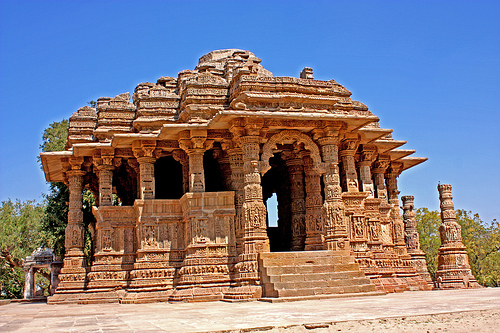Modhera Travel Guide:

Introduction
The Sun Temple Modhera is a temple dedicated to the Hindu Sun-God, Surya. It was built in 1026 AD by King Bhimdev of the Solanki dynasty. Other Sun Temples in India are as follows: at Konark in Orissa, at Martand in Jammu and Kashmir near Almora in Uttarakhand at Gaya, Bihar The Dakshinaarka temple, The Bhramanya Dev Temple at Unao in Madhya Pradesh, Sun Temple at Surya Pahar in Assam Suryanaar Temple at Kumbhakonam in Tamilnadu, Suryanarayanaswamy temple at Arasavilli in Andhra Pradesh, The Sun Temple at Modhera – Gujarat
History
According to the Skanda Purana and Brahma Purana, the areas near Modhera were known during ancient days as Dharmaranya (literally meaning the forest of righteousness). According to these Puranas, Lord Rama, after defeating Ravana, asked sage Vasistha to show him a place of pilgrimage where he could go and purify himself from the sin of Brahma-hatya (the sin of killing a Brahmin, because Ravana was a Brahmin by birth). Sage Vasistha showed him Dharmaranya, which was near the modern town of Modhera. In the Dharmaranya, he settled at a village Modherak and performed a yagna there. Thereafter he established a village and named it Sitapur. This village is about 15 km from Becharaji Modherak village and it subsequently came to be known as Modhera.
The Sun Temple was built by Rushabh Bhimdev I of Solanki Dynasty in AD 1026. This was the time when Somnath and the adjoining area was plundered by Mahmud Ghazni and reeled under the effects of his invasion. The Solankis, however, regained much of their lost power and splendour. Anahilvad Patan, the Solanki capital, was restored to glory. Royalty and traders jointly contributed to build grand temples.
Solankis were considered to be Suryavanshis, or descendants of Sun god. The temple was so designed that the first rays of the sun fell on the image of Surya, the Sun God, at the time equinoxes.
The temple is partially in ruins after it was also finally destroyed by the Allauddin Khilji.
However, enough has remained of the temple to convey its grandeur.
Surya Kund
This Suryakunda also known as Ramakunda is a large rectangular stepped tank measuring 53.6 x 36.6 meters under the east face of sabhamandap used to store pure water. Devotees were required to perform ceremonial ablutions here before worshiping the Sun God.
The Suryakund is finest example of geometry. The organization of stone into composition gives shape to a dazzling pattern of art. It is proportioned with innumerable stone steps leading devotees down to its base. 108 miniature shrines are carved in between the steps inside the tank. Also number 108 considered to be auspicious by Hindus as hindu rosary has same number of beads.
Modhera Dance Festival
To create the enchantment and splendor of our ancient history and rich cultural traditions; Modhera dance festival is scheduled to be held during the third week of January every year, after the festival of Uttarayan for three days in the backdrop of the Sun temple. Renowned Indian artist perform here and enthrall the audience. The objective is to present classical dance forms in an atmosphere they were originally presented in. The festival is organised by the Tourism Corporation of Gujarat.
References
Lobo, Wibke, The Sun-temple at Modhera: A monograph on architecture and iconography (Forschungen zur allgemeinen und vergleichenden Archäologie)
Burgess, Jas & Cousens, Henry, The Architectural Antiquities of Northern Gujrat, Bharatiya Publishing House, Varanasi, 1975
Brown Percy, Indian Architecture (Buddhist and Hindu Periods), D.B. Taraporewala Sons & Co. Ltd. Bombay, 1975
Sankalia, Hasmukh. D., The Archaeology of Gujarat (Including Katiawar), Natwarlal & Co. Publishers, Bombay, 1941
Majumdar, Ashok Kumar, Chaulukyas of Gujarat, Bharatiya Vidya Bhawan, 1956.
an inside look at the glorious sun temple at modhera, published by TCGL, Gandhinagar, 2001.